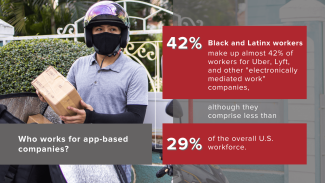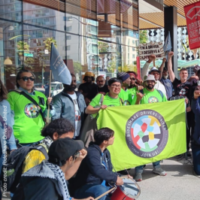Introduction
All of us deserve meaningful work that provides us with the stability and security to thrive as individuals and families, and to build thriving communities and a healthy democracy. For nearly a century, workers have fought for a foundation of rights and protections for all workers. In the last decades, many workers have won higher minimum wages, secure scheduling, paid sick and safe time, and paid family leave in jurisdictions across the United States.
But not all working people are protected by labor rights. Digital labor platform companies such as Uber, Lyft, DoorDash, and Instacart have, ever since their founding during the Great Recession, told their workers that they have no rights as workers, and have dedicated enormous resources to carve them out from labor laws that form a baseline for other workers.[1] The companies’ extensive lobbying efforts led half the states to exempt them mainly or entirely from complying with any state laws whatsoever related to employee rights.[2]
Digital labor platform companies like Uber, Lyft, DoorDash, and Instacart are actively lobbying and marketing for a workplace that forces workers to accept jobs with only a sliver of the baseline rights and protections other workers have.
Digital labor platform companies like Uber, Lyft, DoorDash, and Instacart are actively lobbying and marketing for a workplace that forces workers to accept jobs with only a sliver of the baseline rights and protections other workers have.[3] To back their lobbying and marketing agenda, the companies have funded unscientific surveys, often using misleading questions, and cited the results as evidence that app-based workers are successful, profitable entrepreneurs when the reality is most are barely making ends meet.
This brief provides a roundup of more than a dozen scientific surveys of workers, voters, and taxpayers, as well as independent reviews of data supplied or required by law from “gig” companies, as defined above, on the wages and working conditions of digital labor platform jobs in the United States. We supplement those findings with community-based reports and the voices of workers themselves.
This brief is meant to illustrate the real experiences of app-based workers via worker stories and scientific studies, and to counteract the false narratives being pushed by the companies. We call for universal labor rights for all those who work for a living.
Who works for app-based companies?
I work in restaurants and catering on top of driving for Uber and Instacart. It might seem like being controlled by an algorithm would mean Black people would be treated more fairly, but it just hides the low wages and customer abuse.
–Chris White, driver and president of Philadelphia Drivers Union
Black and Latinx workers provide a disproportionate share of digital labor platform work in the United States. Bureau of Labor Statistics data show that Black and Latinx workers make up almost 42 percent of workers for Uber, Lyft, and other “electronically mediated work” companies, although they comprise less than 29 percent of the overall U.S. workforce.
State-based surveys tell the same story:
- In New York City, 9 out of 10 (86%) app-based ride-hail drivers are immigrants, with half coming from the Dominican Republic, Haiti, Pakistan, India and Bangladesh. Forty-six percent of the overall workforce in New York City is foreign-born (Parrott and Reich 2018).
- In San Francisco, nearly 80 percent of app-based ride-hail and delivery workers are people of color, and a majority are immigrants (Benner et al. 2020). Approximately 61 percent of the overall workforce are people of color (NELP analysis of U.S. Census Bureau, Quarterly Workforce Indicators, First Quarter of 2020) and 32 percent are immigrants (NELP analysis of pooled American Community Survey microdata, 2015-2019). A supplemental San Francisco survey of delivery workers alone found that 76 percent were people of color (Benner et al. 2020, Delivery only).
- In King County, Washington, which includes Seattle, 23 percent of app-based ride-hail drivers are Black, compared to 5 percent of all workers, and drivers are three times more likely to be immigrants than all workers (Parrott and Reich 2020).
- In Los Angeles County, 23 percent of drivers for Uber and Lyft are Black, compared to only 8 percent of the general population (UCLA 2018).
- In New York City, a study of app-based workers found 27 percent of Latinx workers had participated in app-based work over the course of a year, compared to 18 percent of white workers (Lew et al. 2021).
- A study of delivery workers in New York found that most are from minority and marginalized groups within immigrant communities (Figueroa 2021).
U.S. history is rife with instances in which business elites and policymakers exclude Black and Latinx workers from core labor standards or shunt workers of color into a narrow set of low-paying jobs.[4] It is in this context that we examine the real conditions for workers in app-dispatched jobs.

Download the full data brief to read more.
Endnotes
[1] We define “digital labor companies” as companies that use internet-based technology platforms, accessible via personal computing devices like smartphones, to coordinate and manage on-demand piecework in a variety of service industries, from taxi to food delivery to domestic work.
[2] Maya Pinto, Rebecca Smith and Irene Tung, Rights at Risk: Gig Companies’ Campaign to Upend Employment as we Know it, National Employment Law Project, 2019, https://s27147.pcdn.co/wp-content/uploads/Rights-at-Risk-4-2019.pdf.
[3] Josh Eidelson, N.Y. Lawmaker Drops Bid for Uber Driver Union Deal This Year, Bloomberg, June 8, 2021, https://www.bloomberg.com/news/articles/2021-06-08/uber-new-york-union-bill-is-dead-for-this-year-sponsor-says.
[4] Testimony of Rebecca Dixon, National Employment Law Project, From Excluded to Essential: Tracing the Racist Exclusion of Farmworkers, Domestic Workers, and Tipped Workers from the Fair Labor Standards Act, Hearing before the US House of Representatives Education and Labor Committee, Workforce Protections Subcommittee, May 3, 2021, https://s27147.pcdn.co/wp-content/uploads/NELP-Testimony-FLSA-May-2021.pdf.




